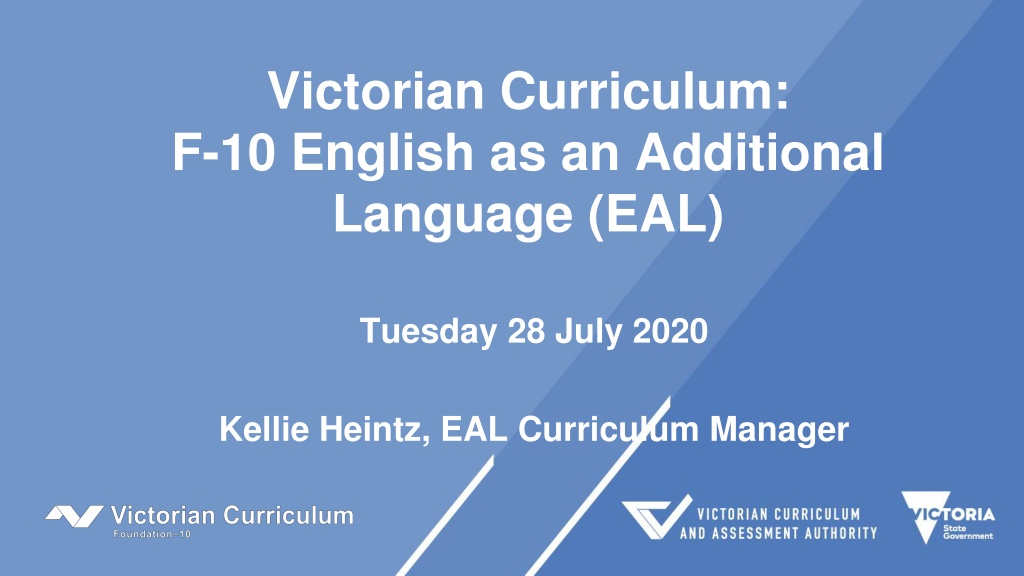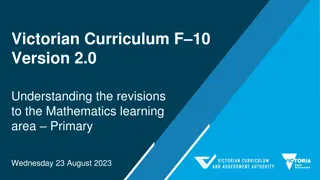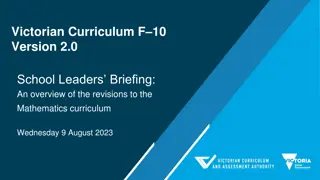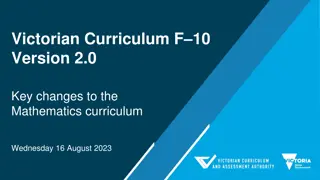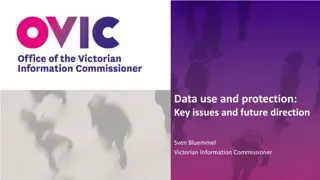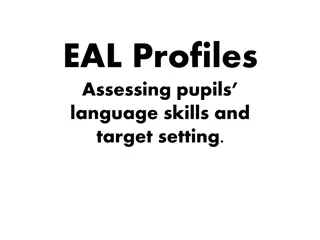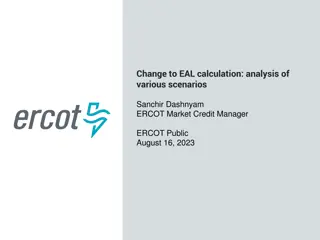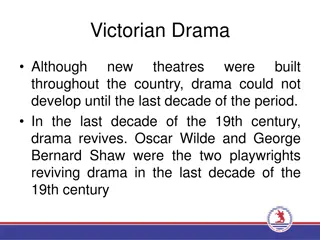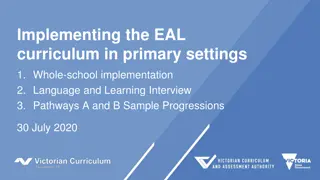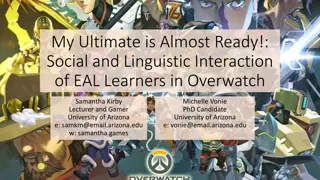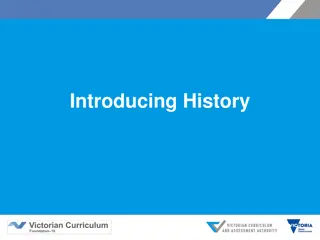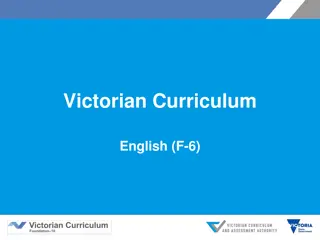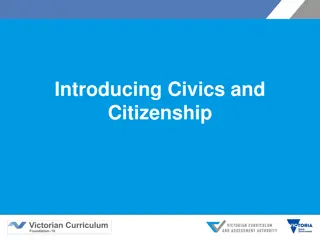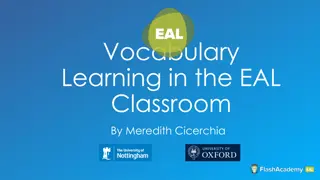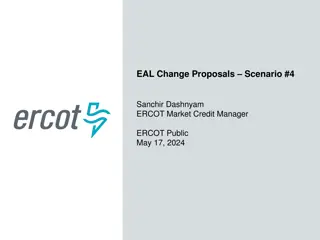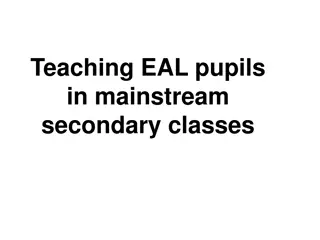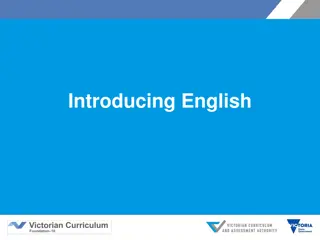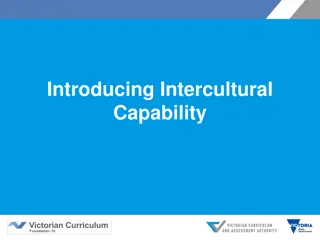Importance of the New Victorian Curriculum F-10 EAL
The new Victorian Curriculum F-10 EAL aims to establish EAL as a standalone curriculum, provide a consistent structure across all learning areas, and recognize the diverse backgrounds and learning experiences of EAL students in Victoria. It also focuses on supporting the specific needs of EAL students who may have multilingual abilities, emphasizing the use of linguistic repertoire to enhance English learning. Teachers play a crucial role in unpacking the curriculum and ensuring EAL learners have access to and demonstrate learning across all areas. The curriculum will be mandated for implementation in government and Catholic schools in 2021.
Download Presentation

Please find below an Image/Link to download the presentation.
The content on the website is provided AS IS for your information and personal use only. It may not be sold, licensed, or shared on other websites without obtaining consent from the author. Download presentation by click this link. If you encounter any issues during the download, it is possible that the publisher has removed the file from their server.
E N D
Presentation Transcript
Victorian Curriculum: F-10 English as an Additional Language (EAL) Tuesday 28 July 2020 Kellie Heintz, EAL Curriculum Manager
Acknowledgment of Country In recognition of Aboriginal and Torres Strait Islander people s spiritual and cultural connection to country, we acknowledge the traditional custodians of the Kulin Nations. We acknowledge the continued care of the lands and waterways over generations and celebrate the continuation of a living culture that has a unique role in this region. We pay our respects to Elders past, present and emerging, for they hold the memories, traditions, culture and hopes of all Aboriginal and Torres Strait Islander peoples across the nation and hope they will walk with us on our journey.
Contents This presentation will cover: the importance of the new Victorian Curriculum F-10 EAL the responsibility of teachers unpacking the curriculum familiarisation with the website and resources plurilingualism as a new addition
2021 In 2021, the Victorian Curriculum F-10 EAL will be mandated for implementation in both government and Catholic schools. Independent schools will be guided by their school.
Why a new EAL curriculum? To establish EAL as a standalone curriculum in its own right To provide a consistent curriculum structure across all of the Victorian Curriculum learning areas To recognise the diverse backgrounds and learning experiences of EAL students in schools across Victoria
Why a new EAL curriculum? To support the specific needs of EAL students To recognise that EAL students might know more than one language, and that they bring with them a linguistic repertoire in that language, that can be used to support the learning of English
A curriculum across all learning areas The Victorian Curriculum F-10 EAL: recognises that students need to access and to demonstrate learning in all learning areas
Teacher responsibility In general, teachers will need to: be aware of EAL learners in their classrooms have a sense of the proficiency levels of their EAL students unpack content-specific language for EAL students be able to plan for and support the language learning of EAL students in order to support their understanding of the different content
What does this mean for schools? The whole school is responsible for planning and implementing the new EAL curriculum. The expertise of specialist EAL teachers needs to be drawn upon. Specialist EAL teachers will need time to work with teachers of EAL students.
Collaboration School leaders will need to consider how the implementation of the EAL curriculum impacts on the whole-school EAL approach. This may mean changing: how all teachers of EAL learners work together who is involved in EAL planning who has oversight of the EAL program Opportunities for specialist EAL teachers to work collaboratively with generalist primary teachers and/or secondary subject teachers will also need to be considered. For government schools, the EAL curriculum school implementation guide is aligned to the FISO Improvement, and provides detailed recommendations on how to implement the EAL curriculum using a whole-school approach.
What might this look like? The specialist English or EAL teacher/s meet with classroom teachers and subject teachers of EAL students to: review student assessment and identify a student s initial pathway on the EAL curriculum refer to the EAL curriculum for examples of appropriate language learning for that pathway consider how the content of a specific learning area may be adapted and scaffolded to support the student s access to language in that subject
Secondary English/EAL teachers Secondary English or EAL teachers report on the English language proficiency of their EAL students using the EAL curriculum.
Secondary school subject teachers Teachers who are not EAL specialists do not need to report on the English language proficiency of their EAL students. Teachers report on their learning area content, as is the current practice.
Unpacking the curriculum The Victorian Curriculum F-10 EAL is: organised by pathways, language modes, strands and sub-strands.
The pathways The Victorian Curriculum F-10 EAL is: a continuum structured as three EAL pathways (A, B, C). Each pathway describes a different stage of English- language learning (early, mid and late), and each pathway is divided into different levels of language learning (A1, A2, BL, B1, B2, B3, CL, C1, C2, C3, C4).
Understanding the pathways EAL Pathway A: Early immersion (Foundation Year 2) Early immersion language learners typically develop their literacy skills through experiences in the school context. Those who have had some experience of formal preschool or school will more readily adapt to the school setting. A student located on EAL Pathway A may have some experience of formal learning in their home language or other languages and some experience of informal prior learning. EAL Pathway A includes two levels of English-language learning: Level A1 and Level A2. Those with little or no experience of English begin at A1; those with some experience may begin at A2. The progress within these levels equates to the rates of progression expected in Foundation Year 2. Generally students who enter Foundation are pre-literate, regardless of their language background, and hence there is no Level AL. EAL students who enter Foundation with minimal literacy in other languages will begin their early immersion in English at Level A1.
Understanding the pathways EAL Pathway B: Mid immersion (Years 3 8) Mid immersion language learners have experience of the social use of language, which they can use as they learn English at school. A student located on EAL Pathway B may have some experience of informal learning in their home language or other languages. Some have yet to experience formal schooling, while others may have experienced formal learning that is equivalent to their English-speaking peers. This may have been in their home language or other languages. EAL learners with little or no English proficiency, fewer than two years of formal learning and minimal home literacy experience will begin this pathway at Level BL, before moving to Level B1. Learners with prior experience of formal learning but no proficiency in English begin at Level B1, and move through Levels B1, B2 and B3. The progress within these levels equates to the rates of progression expected in Years 3 8.
Understanding the pathways EAL Pathway C: Late immersion (Years 7 10) Late immersion language learners have a mature understanding of themselves and their relations with others in different social contexts, and are capable of understanding abstract ideas and relationships in their experience and learning about the world. EAL learners without prior formal learning and with minimal home language literacy experience will begin this pathway at Level CL, before moving to the other levels. Learners with prior experience of formal learning but no proficiency in English will begin on Level C1 and move through Levels C1, C2, C3 and C4. The progress within these levels equates to the rates of progression expected in Years 7 10.
Language modes Speaking & Listening Reading & Viewing Writing
Strands & sub-strands Linguistic structures & features Cultural & plurilingual awareness Communication Grammatical patterns Phonology Grapho- phonics Plurilingual strategies Word Knowledge Cultural understandings Communication Text structure & organisation
An online tour of the curriculum https://victoriancurriculum.vcaa.vic.edu.au/english/english -as-an-additional-language-eal/introduction/rationale-and- aims
Plurilingualism The ability of a person who has competence in more than one language to switch between them where necessary for ease of communication and learning. It is the interconnected knowledge of multiple languages.
Plurilingual strategies Provide opportunities for EAL learners to: draw on the linguistic and cultural repertoire of other languages to support the learning of both content and the English language
Plurilingual strategies There are no content descriptions relating to plurilingual strategies, and they are not included in the achievement standards. Teachers do not assess students achievement in other languages.
Plurilingualism at work CL C1 C2 C3 C4 Distinguish spoken English from other languages and attempt to respond in English Use sentence patterns from home language to communicate ideas Transfer some simple language structures to other contexts Check understanding of classroom English by asking for clarification from other home language speakers Use home language to formulate speech in English and communicate ideas Transfer knowledge from home language to English learning Ask for the translation of specific words from other home language speakers Explain the home language meaning of unfamiliar English words and phrases to home language peers Clarify in home language to check understanding Discuss a point of language Use home language resources to support use of English Transfer academic and communication skills from home language to English Use home language resources to develop English Compare and contrast different ways of communicating meanings in home language and English Talk about cultural differences related to communication
Next session Implementing the curriculum in primary settings Thursday 30 July 2020 3.45pm-4.45pm This session will focus on planning for implementation across a primary school, unpacking Pathways A & B and how to use the Language & Learning Interview.
Further sessions 4/8/20 3.45pm- 4.45pm 3. Implementing the curriculum in secondary settings This presentation will focus on unpacking Pathways: B and C, and how to use the Language and Learning Interview to understand the needs of EAL students. 6/8/20 3.45pm-4.45pm 4. Implementing the curriculum for newly arrived students in Language schools, centres and programs This presentation will focus on unpacking the EAL Pathways, and how to use the curriculum to meet the specific needs of newly arrived EAL students. 11/8/20 3.45pm-4.45pm 5. Unpacking the curriculum for experienced teachers This presentation will focus on unpacking the curriculum for teachersfamiliar with the EAL Developmental Continuum. 13/8/20 3.45pm-4.45pm 6. Unpacking the curriculum for new teachers of EAL students This presentation will focus on unpacking the curriculum for new teachers of EAL students. 7. What is Plurilingualism? This presentation will explore plurilingualism and the ways it can be used to enhance the teaching of EAL students. 13/10/20 3.45pm-4.45pm 15/10/20 3.45pm-5.00pm 8. Ways to assess and report on the curriculum This presentation will be conducted as a panel discussion. Representatives from DET and CEM will provide advice about the ways to assess and report on the curriculum in each sector. 20/10/20 3.45pm-4.45pm 9. Suggestions about whole school curriculum planning This presentation will provide ideas and examples of the ways that schools may approach whole school curriculum planning for EAL.
Contact For any questions concerning the EAL curriculum, please contact me: Kellie Heintz, EAL Curriculum Manager, VCAA Kellie.Heintz@education.vic.gov.au
